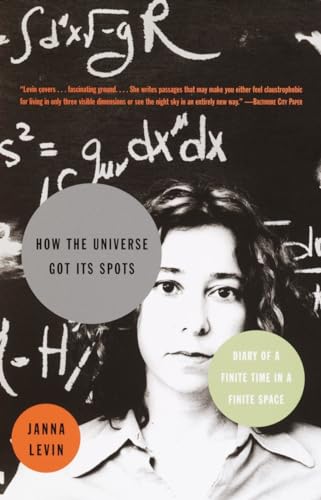Articles liés à How the Universe Got Its Spots: Diary of a Finite Time...

Synopsis
Is the universe infinite or just really big? With this question, the gifted young cosmologist Janna Levin not only announces the central theme of her intriguing and controversial new book but establishes herself as one of the most direct and unorthodox voices in contemporary science. For even as she sets out to determine how big "really big" may be, Levin gives us an intimate look at the day-to-day life of a globe-trotting physicist, complete with jet lag and romantic disturbances.
Nimbly synthesizing geometry, topology, chaos and string theories, Levin shows how the pattern of hot and cold spots left over from the big bang may one day reveal the size and shape of the cosmos. She does so with such originality, lucidity--and even poetry--that How the Universe Got Its Spots becomes a thrilling and deeply personal communication between a scientist and the lay reader.Les informations fournies dans la section « Synopsis » peuvent faire référence à une autre édition de ce titre.
À propos de l?auteur
JANNA LEVIN is a professor of physics and astronomy at Barnard College of Columbia University. She is also director of sciences at Pioneer Works, a center for arts and sciences in Brooklyn, and has contributed to an understanding of black holes, the cosmology of extra dimensions, and gravitational waves in the shape of spacetime. Her previous books include How the Universe Got Its Spots and a novel, A Madman Dreams of Turing Machines, which won the PEN/Bingham Prize. She was recently named a Guggenheim fellow.
Les informations fournies dans la section « A propos du livre » peuvent faire référence à une autre édition de ce titre.
EUR 3,78 expédition depuis Etats-Unis vers France
Destinations, frais et délaisRésultats de recherche pour How the Universe Got Its Spots: Diary of a Finite Time...
How the Universe Got Its Spots: Diary of a Finite Time in a Finite Space
Vendeur : ThriftBooks-Dallas, Dallas, TX, Etats-Unis
Paperback. Etat : Very Good. No Jacket. May have limited writing in cover pages. Pages are unmarked. ~ ThriftBooks: Read More, Spend Less 0.59. N° de réf. du vendeur G1400032725I4N00
Quantité disponible : 1 disponible(s)
How the Universe Got Its Spots: Diary of a Finite Time in a Finite Space
Vendeur : ThriftBooks-Atlanta, AUSTELL, GA, Etats-Unis
Paperback. Etat : Very Good. No Jacket. Former library book; May have limited writing in cover pages. Pages are unmarked. ~ ThriftBooks: Read More, Spend Less 0.59. N° de réf. du vendeur G1400032725I4N10
Quantité disponible : 1 disponible(s)
How the Universe Got Its Spots: Diary of a Finite Time in a Finite Space
Vendeur : ThriftBooks-Reno, Reno, NV, Etats-Unis
Paperback. Etat : Very Good. No Jacket. May have limited writing in cover pages. Pages are unmarked. ~ ThriftBooks: Read More, Spend Less 0.59. N° de réf. du vendeur G1400032725I4N00
Quantité disponible : 1 disponible(s)
How the Universe Got Its Spots: Diary of a Finite Time in a Finite Space
Vendeur : ThriftBooks-Atlanta, AUSTELL, GA, Etats-Unis
Paperback. Etat : As New. No Jacket. Pages are clean and are not marred by notes or folds of any kind. ~ ThriftBooks: Read More, Spend Less 0.59. N° de réf. du vendeur G1400032725I2N00
Quantité disponible : 1 disponible(s)
How the Universe Got Its Spots: Diary of a Finite Time in a Finite Space
Vendeur : ThriftBooks-Atlanta, AUSTELL, GA, Etats-Unis
Paperback. Etat : Very Good. No Jacket. May have limited writing in cover pages. Pages are unmarked. ~ ThriftBooks: Read More, Spend Less 0.59. N° de réf. du vendeur G1400032725I4N00
Quantité disponible : 1 disponible(s)
How the Universe Got Its Spots: Diary of a Finite Time in a Finite Space
Vendeur : ThriftBooks-Dallas, Dallas, TX, Etats-Unis
Paperback. Etat : Good. No Jacket. Pages can have notes/highlighting. Spine may show signs of wear. ~ ThriftBooks: Read More, Spend Less 0.59. N° de réf. du vendeur G1400032725I3N00
Quantité disponible : 1 disponible(s)
How the Universe Got Its Spots : Diary of a Finite Time in a Finite Space
Vendeur : Better World Books, Mishawaka, IN, Etats-Unis
Etat : Good. Former library book; may include library markings. Used book that is in clean, average condition without any missing pages. N° de réf. du vendeur 7925021-6
Quantité disponible : 1 disponible(s)
How the Universe Got Its Spots : Diary of a Finite Time in a Finite Space
Vendeur : Better World Books, Mishawaka, IN, Etats-Unis
Etat : Very Good. Used book that is in excellent condition. May show signs of wear or have minor defects. N° de réf. du vendeur 4174198-6
Quantité disponible : 1 disponible(s)
How the Universe Got Its Spots : Diary of a Finite Time in a Finite Space
Vendeur : Better World Books, Mishawaka, IN, Etats-Unis
Etat : Good. Used book that is in clean, average condition without any missing pages. N° de réf. du vendeur 4493078-6
Quantité disponible : 2 disponible(s)
How the Universe Got Its Spots: Diary of a Finite Time in a Finite Space
Vendeur : Wonder Book, Frederick, MD, Etats-Unis
Etat : Very Good. Very Good condition. A copy that may have a few cosmetic defects. May also contain light spine creasing or a few markings such as an owner's name, short gifter's inscription or light stamp. N° de réf. du vendeur L03G-00111
Quantité disponible : 1 disponible(s)

